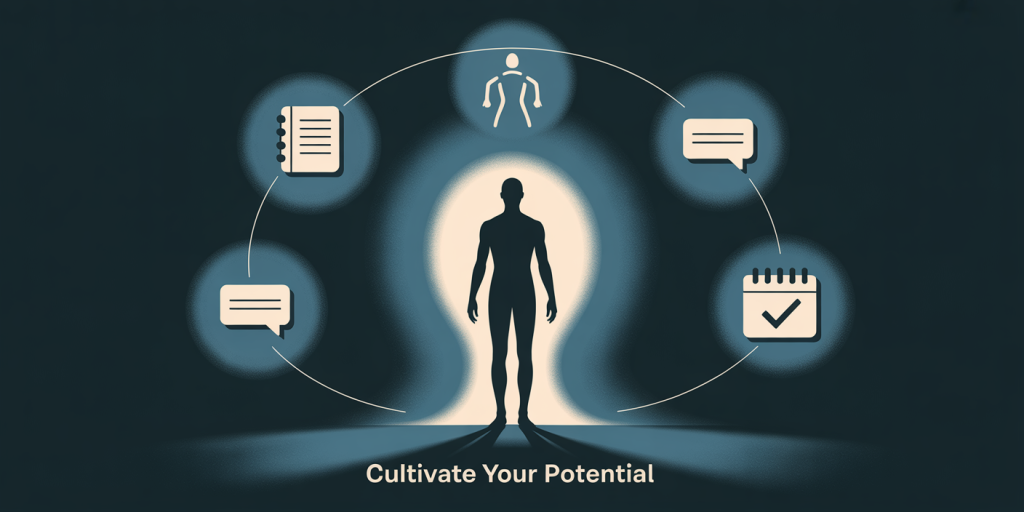The Confidence Code: Small Habits That Make You Speak and Lead with Authority
Confidence isn’t something we’re born with—it’s something we build. While some people may appear naturally confident, what we often don’t see are the small, consistent habits that shape how they speak with power, carry themselves in a room, and lead with clarity. Authority isn’t about being loud or dominant—it’s about being grounded, intentional, and persuasive.
In this article, we’ll break down “The Confidence Code” into practical, everyday actions that can transform how others perceive you—and how you perceive yourself. Whether you’re leading a team, presenting an idea, or simply trying to be heard in a conversation, these small habits can make a big difference.
🔑 What Does It Mean to Lead and Speak with Authority?
Speaking and leading with authority means:
- You project clarity, not confusion.
- People listen when you speak, not because you’re the loudest, but because your words carry weight.
- You inspire action, not just attention.
- You own your space—physically, verbally, and mentally.
Authority comes from a mix of confidence, competence, and presence. And these qualities are built—not gifted.

🧠 The Confidence-Authority Loop
Confidence and authority feed each other. When you practice small habits that make you look and sound more confident, people respond with trust and respect. This positive feedback reinforces your self-belief, which makes you even more confident the next time.
The key is starting with behavior. You don’t need to wait until you “feel confident” to act confidently. You can reverse-engineer confidence through intentional actions.

📌 Habit #1: Stand and Sit Like You Belong There
Body language shapes perception—both others’ and your own.
People subconsciously associate posture with competence. If you slump, avoid eye contact, or shrink into yourself, you signal doubt. If you stand tall, move with intention, and make eye contact, you signal leadership—even if you’re nervous.
Try this:
- Keep shoulders back and spine straight (but relaxed)
- Uncross your arms—keep an open posture
- Plant both feet on the ground when standing or sitting
- Use purposeful gestures when you speak
- Avoid fidgeting or touching your face
These small adjustments create presence and increase self-assurance.
🗣️ Habit #2: Eliminate “Weak Language” from Your Speech
How you phrase things has a direct impact on how people perceive your confidence.
Avoid phrases that undermine your authority, such as:
- “I think maybe…”
- “I’m not an expert, but…”
- “Sorry to bother you…”
- “Does that make sense?”
Replace them with assertive alternatives:
- “I believe…” or “My perspective is…”
- “Based on my experience…”
- “Let’s move forward with…”
- “Here’s what we can do…”
Bonus tip:
Use short, direct sentences. They land stronger and convey clarity.
🎙️ Habit #3: Practice the Power of the Pause
Confident speakers are not afraid of silence.
When you pause, you:
- Give weight to your words
- Appear calm and thoughtful
- Prevent filler words like “um,” “like,” and “you know”
Instead of rushing, slow down. Make your key points stand out by giving them breathing room.
Example:
“This strategy will increase revenue. (pause) It will also improve retention.”
A simple pause changes the tone from rushed to authoritative.
📝 Habit #4: Prepare (But Don’t Over-Prepare)
Preparation is essential—but over-preparing can backfire. You don’t want to sound like you’re reading a script.
The most confident communicators internalize their ideas rather than memorize every word.
Try this:
- Know your key message in every conversation or meeting
- Outline 3 supporting points you want to hit
- Practice speaking them aloud in your own words
- Use bullet points—not full scripts—when preparing
Confidence comes from knowing what you want to say, not reciting it perfectly.
🧭 Habit #5: Make Eye Contact with Purpose
Eye contact builds trust. Avoiding it makes you appear unsure or disengaged.
When speaking to a group:
- Make eye contact with one person at a time for a few seconds
- Rotate naturally around the room
- Avoid scanning too quickly or staring uncomfortably
When speaking one-on-one:
- Maintain eye contact around 60–70% of the time
- Look away occasionally to avoid intensity, but always return to the person
This habit grounds you in the moment and connects you with your audience.
💬 Habit #6: Ask Powerful Questions
Confident people don’t feel the need to have all the answers—they know the value of asking good questions.
Use questions to:
- Show curiosity and intelligence
- Clarify expectations
- Guide conversations toward outcomes
Example:
Instead of saying, “I’m not sure what to do,” ask:
“What’s the most important outcome we want here, and how can I contribute to that?”
Leading with questions doesn’t dilute your authority—it amplifies it.
🧩 Habit #7: Know Your Value—and Own It
People who lead with authority believe they bring value, and they communicate from that place.
Build this habit by regularly reflecting on:
- Wins you’ve had (big or small)
- Problems you’ve solved
- Compliments you’ve received
- Unique perspectives or skills you offer
Keep a “confidence file”—a note in your phone or journal where you collect reminders of your impact. Review it before important conversations, interviews, or meetings.
When you speak from a place of inner worth, people feel it—even if you say little.
📢 Habit #8: Speak First in Meetings
It’s a small move, but a powerful one.
By speaking up early in a group setting, you:
- Establish presence
- Influence the tone of the discussion
- Reduce the likelihood of getting “lost in the room”
Even if you just ask a thoughtful question or agree with someone’s idea, get your voice in early. The longer you wait, the harder it feels to contribute.
🔄 Habit #9: Practice Confidence Daily (Even in Small Moments)
Confidence isn’t reserved for big presentations or boardroom talks—it’s shaped in everyday interactions.
Daily opportunities to practice:
- Ordering food with clear, polite speech
- Introducing yourself to someone new
- Asking for help at a store
- Speaking up in casual group chats
- Posting your thoughts on social media
These micro-habits train your nervous system to get comfortable being seen and heard.
🛡️ Habit #10: Reframe Fear as a Sign of Growth
Many people think they need to eliminate fear before they feel confident. But the truth is, confidence comes from action, not the absence of fear.
Next time you feel nervous:
- Acknowledge it without judgment
- Reframe it as excitement or growth
- Act anyway—just 10 seconds of courage can change everything
Remember: even confident leaders feel fear. The difference is, they don’t let it stop them.
🎯 Final Thoughts: Confidence Is a Muscle—Train It
You don’t need to become a different person to lead with authority. You just need to build the right habits, one small shift at a time.
Let’s recap:
- Stand and speak like you belong
- Cut weak language from your speech
- Use pauses to add power
- Prepare with purpose—not perfection
- Make strong eye contact
- Ask smart questions
- Own your value
- Speak up early
- Practice daily
- Use fear as fuel
Confidence isn’t about never doubting yourself. It’s about acting with clarity and intention even when you do.
Start today—with one small habit. Then another. Your voice, your presence, and your leadership will grow stronger with every choice you make.

